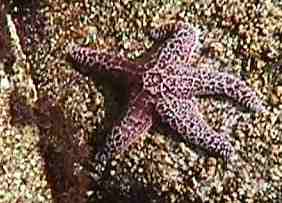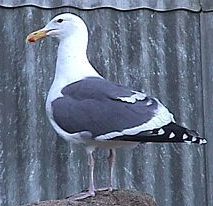There are no fresh water echinoderms. This may be why people most often associate the sea with sea urchins and starfish, more than any other organisms. Echinoderms are a very successful group, first showing up in the fossil record some 600,000,000+ years ago. Though at their peak there were as many as 20,000 species there are still a respectable 6,000 species today. They occur at all depths and in all climates (see Classification Tree).
We will be primarily concerned with the sea urchins, 700 species, as this is the organism we use in our work. What they lack in species, they make up for in numbers. It is thought that the primary macroscopic organism on the deep sea floor is the sea urchin.


Pat Antonio's collection,
Pacific Grove, CA.
Habitat
Sea urchins live only in the ocean and cannot survive in fresh water. They are found from the intertidal to the deep ocean. The species that we are likely to use in the lab are either from the intertidal or the shallow subtidal.


These "Urchin Beds" can extend for acres in the intertidal and house tens of thousands of sea urchins and many other life forms.
Not much in the way of seaweed grows in the intertidal that the sea urchins have not already "mowed" down. They then feed on seaweed that washes up into the intertidal by winter storms from the subtidal regions. This may explain why these species are most gravid in the winter months.

Distribution (of species used at SUE)
Strongleocentrotus francicanus (red sea urchin, up to 10" diameter) and S. purpuratus [purple sea urchin, up to 5" diameter] are shown in light purple [Baja to Alaska]. S. drobachensis (green sea urchin, 4-5" diameter) in green and Lychechinus pictus (1-2" diameter) in yellow (see classified).
(Monterey in red)

Eating And Eaten
Food:

Sea urchins have also been known to eat meat, including each other! No wonder they have spines. Different strategies are employed to "catch" the food. Some species will hang out in their rock burrows (carved out of solid rock by years of rubbing their spines against the rock) and wait for the seaweed to come to them. This works pretty well in the intertidal. Not surprisingly, the breeding season in Stronglyocentrotus purpuratus corresponds with the influx of kelp broken off in the winter storms. Other species actively search out kelp from yards away, "smelling" their favorite food in the water and making a line straight for it, as in the case of the subtidal urchin Lytechinus pictus.
In the absence of predators, sea urchins can really do a number on a kelp bed. The area becomes the subtidal equivalent of a desert. Many other, non-urchin, species depend on kelp for food as well as shelter and when the sea urchins have done their work, a whole community disappears. Kelp grows from the tip by splitting of the terminal frond. Unfortunately, sea urchins attack at the base, often cutting the entire plant loose from the ocean floor (see Ecology Nightmare).

growing tip of Macrocystis
© Langstroth
Predators:

In 2000 in California, 20 million lbs of sea urchins were harvested, primarily for markets in Japan. This is a decline from the nearly 52 million pounds in 1988. Though sea otters eat an impressive amount of food, consuming their own body weight in hours, they do not come close to humans in their destructiveness.



Seagulls prey upon intertidal sea urchins. They use their beaks to break open the shells and eat the gonads inside.
To protect themselves intertidal sea urchins will pile rocks and shells on top of themselves. Over generations they create scooped out burrows in the soft rock, sometimes trapping themselves in a self-made prison.
Bacteria also take their toll. There have been infections in years of bad weather or poor food supply when the population is more susceptible. Stronglyocentrotus species suffer from attacks from common bacteria in the ocean of the Rhodospirillum genus. These bacteria are purple, like the urchin, and cause purple necrotic spots to appear on the outside of the sea urchin. The spines and tube feet fall off in this area and eventually the infection eats its way into the shell, killing the urchin. (Surprisingly the sea urchin can live for months with a hole in its side). If you ever get this infection in your tank of sea urchins, the antibiotic, Chloramphenicol, is very effective at treating the infection. (1 gram / 50 gallons of tank sea water).
Commensals:
Besides the worms already mentioned, small fish will hide in the spines, as well as young sea urchins, feeding off the smaller bits of leftovers from the adults. Hermit crabs will often hang out near sea urchins to eat leftovers also, as well as finish off any sea urchin that falls prey to another organism or dies of a sickness.
See "What is the average life of a sea urchin?"
Indicator Organism:
Sea urchins are used in public aquariums as an indicator organism for water quality. If there is something wrong with the tank, sea urchins will be one of the first organisms to show signs of stress (stop moving, spines lie down, and of course death). This makes them excellent organisms to use for studies on pollution.
The Environmental Protection Agency uses sea urchin fertilization and development as an indicator of water quality for waters near our shores and bays. The Experiments lab makes use of this same idea in proposing experiments that can be done in the classroom, studying the effects of common household pollutants.
